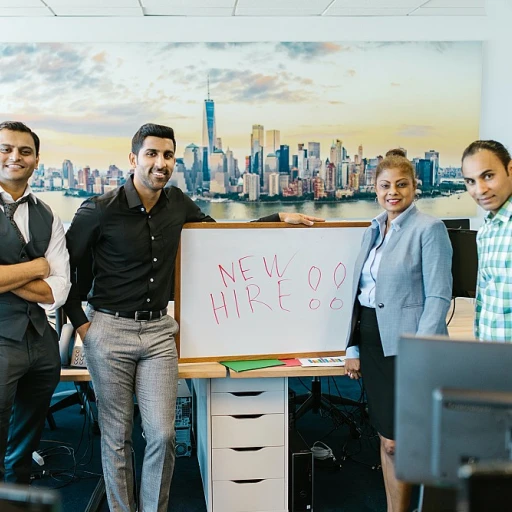Understanding the Forming Phase
Initiating the Journey in Team Dynamics
The forming stage represents the onset of a team's journey in the widely recognized Tuckman model of group development. As teams assemble for the first time, the primary focus lies in understanding roles, responsibilities, and the objectives of the project at hand. Team members are usually polite and cautious, aiming to avoid conflict while establishing preliminary relationships and navigating new dynamics. During this stage, group members begin the introduction phase where they seek familiarity and clarity. Questions arise regarding the purpose of the group, individual roles, and expectations. This forms the foundation of team development and sets the tone for how the team will function moving forward. It's a time filled with excitement and curiosity, but it can also be overwhelming as members are yet to settle into their roles. The forming stage is crucial as it lays the groundwork for subsequent stages like storming and norming. Teams must ensure open communication and foster an inclusive environment to smoothly transition to the next stages. Understanding this early phase is essential to mitigate potential challenges during the later stages of team development, such as conflict management and problem-solving. While the forming phase is relatively calm, leadership plays a critical role in providing direction and clarity. Establishing team goals and shared values right from the start helps alleviate uncertainties and sets a course for constructive development. By laying out clear objectives and an understanding of team dynamics, this stage sets a foundation for moving forward into the more challenging storming stage.The Storming Phase: Challenges and Opportunities
Overcoming Hurdles and Harnessing Potential
The storming phase, often regarded as a turbulent time in team development, is where disagreements and challenges can arise. As teams transition from the forming stage, group members start to push against established boundaries. This stage is crucial as it lays the groundwork for more cohesive group development, eventually leading to the norming performing stages.
During this phase, differences in opinions and working styles among team members can create conflicts and challenges. The storming stage can be challenging as individuals within the team may compete for roles, leading to a lack of unity. Recognizing these signs early can be vital in helping the team move forward.
However, it's not all hurdles and conflicts. The storming phase also presents opportunities for team development. Members learn essential problem-solving skills and develop a better understanding of each other's strengths and weaknesses. This process enhances team dynamics, aiding in the transition towards the norming and performing stages.
The presence of effective leadership during this stage can significantly impact the team's progress. Leaders help navigate through the storming challenges, fostering an environment where open communication is encouraged. This allows team members to voice their concerns and ideas, further assisting in overcoming this turbulent period.
Despite its challenges, the storming stage is a critical component of Bruce Tuckman's stages of group development model. It serves as a stepping stone towards achieving a performing team where members work seamlessly. To learn about effective team-building activities that can enhance employee engagement during this phase, consider exploring effective team-building activities.
Strategies for Navigating Forming and Storming
Key Strategies for Navigating the Initial Phases
Successfully guiding a team through the initial forming and storming phases requires a thoughtful and deliberate approach. Understanding these stages, as outlined in the Tuckman model of group development, can significantly aid in this process. Below are some effective strategies to help teams navigate these phases smoothly.
- Foster Open Communication: Encourage regular and honest dialogue among team members. This involves creating an atmosphere where everyone feels comfortable sharing their thoughts and concerns. Such openness can prevent misunderstandings and build trust.
- Set Clear Objectives: During the forming stage, it is crucial to define the team's goals and expectations clearly. This gives group members a sense of purpose and direction, facilitating smoother transitions into later stages like norming and performing.
- Embrace Conflict Management: The storming stage often brings about conflicts as team members begin to assert their ideas and roles. Embracing conflict management techniques is vital. Encourage members to view conflict as an opportunity for growth and innovative problem solving, rather than a setback.
- Role Clarity and Delegation: Clearly defined roles help eliminate confusion and overlap of responsibilities. In the development process, a well-delegated project plan can prevent potential friction and streamline the workflow.
- Provide Constructive Feedback: Continuous feedback ensures that group members are aware of their progress and areas that need improvement. Constructive feedback is a powerful tool for growth and keeps the focus on development rather than criticism.
- Leverage Leadership Presence: Effective leadership is essential at every stage. Leaders should guide the team with empathy and awareness, helping members transition past the storming stage by demonstrating visionary thinking and bolstering morale.
- Engage in Team Building Activities: Structured team-building activities can significantly enhance cohesion and mutual understanding among members. Activities that foster connections can facilitate smoother navigation through storming and later norming.
As teams move through these stages, it is crucial to adapt and mold strategies to fit the unique dynamics of the group. Remaining flexible and responsive to the team's needs while relying on proven strategies can effectively guide a team from formation to high performance. For more insights on enhancing employee engagement, consider exploring approaches such as convergence training, which can also support teams throughout this development journey.
The Role of Leadership in Team Development
Emphasizing Leadership in Effective Team Progression
Leadership plays a vital role in guiding teams through the challenging phases of forming and storming. The role of leadership becomes particularly critical as groups transition from the forming stage to the storming stage, navigating through the turbulence and uncertainties that characterize this phase. Effective leadership can steer the group's progress toward the norming and performing stages, ensuring team development is on track. A leader should cultivate open communication within the team. This involves encouraging members to express their ideas and concerns freely, fostering a safe space for dialogue. It's crucial for leaders to model active listening and empathy, helping team members feel heard and valued. Moreover, setting a clear vision and goals provides direction and motivates the group as they push through the storming phase. By offering clarity, leaders help the team understand their individual roles and the collective aims of the project. Leaders also need to be adept at conflict resolution. The storming phase often introduces disagreements as team members vie for roles or confront differences in opinion. Acting as mediators, leaders can facilitate discussions and promote collaborative problem-solving among members. Providing timely feedback is another important aspect of leadership during this stage. Constructive feedback helps team members improve their work process and align with the group's goals, laying the groundwork for the transition into the norming and eventually the performing stage. The competence and approachability of a leader have a direct impact on team dynamics. Encouraging collaboration, offering support, and maintaining a positive work environment increases the chances of successful team development, moving smoothly through the Tuckman model stages. In summary, leadership in team development is not just about steering the ship. It's about cultivating an environment that allows team members to thrive, ultimately leading to a cohesive and high-performing team.Building a Supportive Workplace Culture
Fostering a Culture of Support in the Workplace
Creating a supportive workplace culture plays a crucial role in employee engagement during the various phases of team development. When teams are transitioning through stages such as forming, storming, and eventually reaching the norming and performing stages, a supportive environment helps in maintaining motivation and commitment. A supportive workplace culture facilitates open communication, which is vital during the storming and norming stages. As groups face challenges, addressing conflicts constructively aids in problem-solving and enhances team dynamics. Encouraging members to voice their concerns during meetings without fear of judgment helps to build trust and cooperation. Moreover, the forming stage benefits from a culture that reinforces inclusivity and respect, helping to ease new members into existing teams. This stage involves a lot of learning and adjustment as team members begin forming initial relationships and understanding roles. A positive cultural environment supports each member through this initial development process. Performance recognition is also crucial. It not only boosts morale but also helps teams in the norming and performing stages to strive for greater achievements. Celebrating successes, whether they're reaching project milestones or implementing effective problem-solving strategies, promotes a sense of accomplishment and further aligns with the development cycle described by Bruce Tuckman's model. Finally, leadership that models these cultural values strengthens the foundation for group development. Leaders who embody supportive practices set the tone for team interactions, encouraging a culture that values team members' contributions and advances group cohesion. By fostering such an environment, workplaces not only improve individual and team performance but also enhance overall employee engagement.Measuring Success in Team Development
Evaluating Team Progress and Success
When it comes to measuring success in team development, especially as teams transition through the forming, storming, norming, and performing stages, it's essential to look beyond traditional metrics. Understanding each stage of the process, as described by the Tuckman model, can provide insights into how to effectively gauge where your team stands and what steps are necessary to propel them forward. Recognition of milestones achieved during the development process is crucial. Whether your team is working through the forming stage or tackling the challenges of the storming stage, acknowledging accomplishments can foster a sense of achievement and motivate team members. Here are some key points to consider:- Engagement and Communication: One of the foremost indicators of a team’s success is the level of engagement and communication among team members. Open lines of communication empower teams to navigate complex storming and norming stages and promote a culture of transparency.
- Conflict Resolution: The ability to effectively manage conflicts during the storming phase can set the tone for future interactions. A team's capacity for problem-solving and conflict resolution can be a benchmark for their readiness to enter the norming stage, where they begin to perform more cohesively.
- Role Clarity and Accountability: During group development, clarity in roles and accountability measures should be established. This becomes particularly important in the performing stage, where efficiency and productivity are pivotal.
- Achievement of Goals: Whether short-term or long-term, assessing whether the team meets its goals can be a testament to the development process. This is particularly pertinent in the performing stage where teams are most efficient.
- Feedback Mechanisms: Implementing regular feedback sessions can help identify areas for improvement and recognize successes. It’s crucial that leadership fosters an environment where team members feel comfortable sharing their thoughts.












